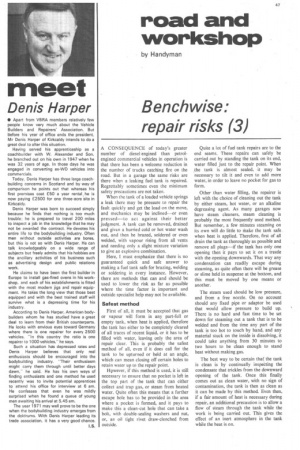Benchwise: repair risks (3)
Page 49

If you've noticed an error in this article please click here to report it so we can fix it.
A CONSEQUENCE of today's greater number of diesel-engined than petrolengined commercial vehicles in operation is that there has been a welcome reduction in the number of trucks catching fire on the road. But in a garage the same risks are there when a leaking fuel tank is repaired. Regrettably sometimes even the minimum safety precautions are not taken.
When the tank of a loaded vehicle springs a leak there may be pressure to repair the fault quickly and get the load on the move, and mechanics may be inclined---or even pressed--to act against their better judgment. A tank can be removed, drained and given a hurried cold or hot water wash out, and then be brazed, soldered or even welded, with vapour rising from all vents and needing only a slight mixture variation to give an explosive combination.
Here, I must emphasize that there is no guaranteed quick and safe answer to making a fuel tank safe for brazing, welding or soldering in every instance. However, there are methods that can and should be used to lower the risk as far as possible where the time factor is important and outside specialist help may not be available.
Safest method First of all, it must be accepted that gas or vapour will form in any part-full or empty tank, when heat is applied, therefore the tank has either to be completely cleared of all traces of recent liquid, or it has to be filled with water, leaving only the area of repair clear. This is probably the safest method of all, even if it does call for the tank to be upturned or held at an angle, which can mean closing off certain holes to retain water up to the repair point.
However, if this method is used, it is still necessary to ensure that no pocket is left in the top part of the tank that can either collect and trap gas, or steam from heated water. Quite often this means that a further escape hole has to be provided in the area where a pocket is formed, and it pays to make this a clean-cut hole that can take a bolt, with double-sealing washers and nut, or, an oil tight rivet draw-clenched from outside.
Quite a lot of fuel tank repairs are to the end seams. These repairs can safely be carried out by standing the tank on its end, water filled just to the repair point. When the tank is almost sealed, it may be necessary to tilt it and even to add more water, in order to leave no pocket for gas to form.
Other than water filling, the repairer is left with the choice of cleaning out the tank by either steam, hot water, or an alkaline degreasing agent. As many garages now have steam cleaners, steam cleaning is probably the most frequently used method. But remember, a few minutes steaming on its own will do little to make the tank safe when heat is applied. Therefore, first of all drain the tank as thoroughly as possible and remove all plugs—if the tank has only one opening then it pays to set it on a trestle with the opening downwards. That way any condensation can readily escape during steaming, as quite often there will be grease or slime held in suspense at the bottom, and this must be moved by one means or another.
The steam used should he low pressure, and from a free nozzle. On no account should any fixed pipe or adaptor be used that would allow pressure to build up. There is no hard and fast time to be set down for steaming out a tank that is to be welded and from the time any part of the tank is too hot to touch by hand, and any material stuck on the inside is dissolving, it could take anything from 30 minutes to two hours to be clean enough to stand heat without making gas.
The best way to be certain thaf the tank is clean is by continually inspeCting the condensate that trickles from the downward opening of the tank. Once this finally comes out as clean water, with no sign of contamination, the tank is then as clean as it can be made by this method. Even then, if a fair amount of heat is necessary during repair, an additional precaution is to allow a flow of steam through the tank while the work is being carried out. This gives the effect of an inert atmosphere in the tank while the heat is on.




































































































































